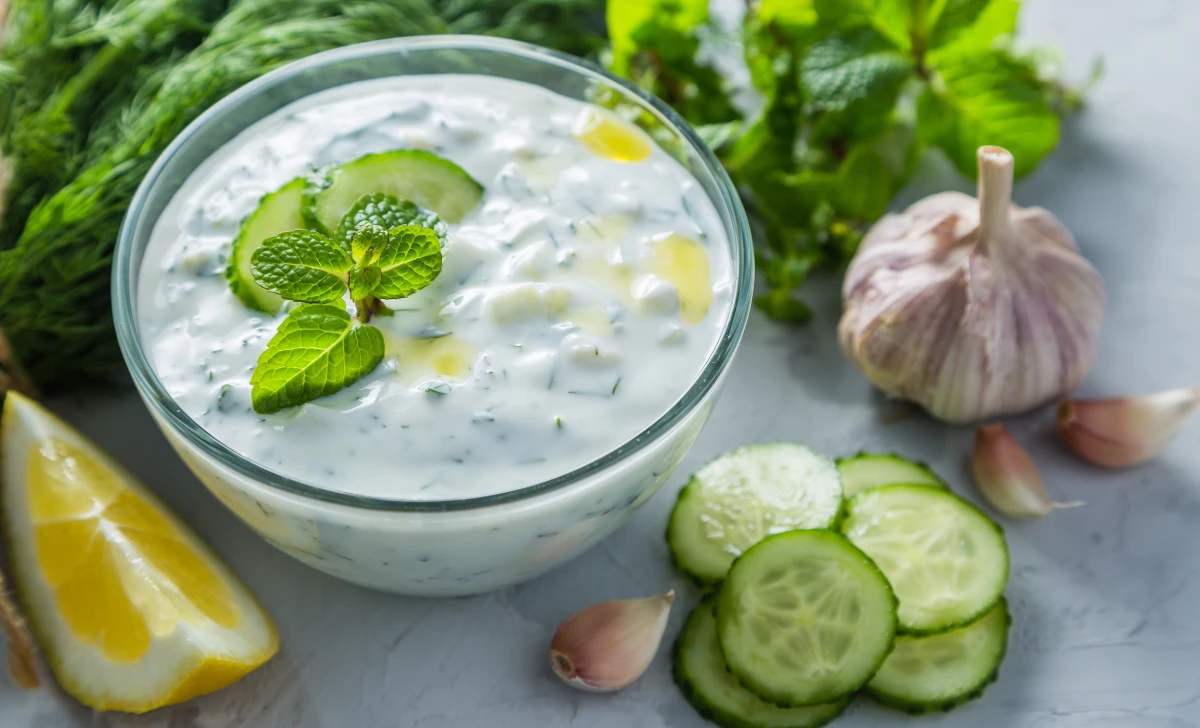Tzatziki is a delectable Mediterranean yogurt-based sauce or dip known for its fresh, tangy flavors. This versatile condiment complements a wide range of dishes and is surprisingly simple to prepare at home. In this article, we will guide you through creating the perfect Tzatziki.
[ez-toc]
History
The history of Tzatziki is as rich and flavorful as the dish itself. This popular Greek condiment has a deep-rooted culinary tradition that spans centuries. Let’s delve into the historical journey of Tzatziki:
Ancient Roots:
Tzatziki’s origins can be traced back to ancient Greece, where it was a staple in their cuisine. The Greeks were known for their fondness for yogurt, cucumbers, and garlic, and these ingredients formed the basis of Tzatziki. The combination of these simple elements created a refreshing and savory sauce that was beloved in ancient Greek households.
Culinary Evolution:
As Greek cuisine evolved over the centuries, so did Tzatziki. It wasn’t just a condiment but a significant component of various dishes. It often accompanied grilled meats, such as souvlaki and gyros, adding a delightful contrast to the smoky flavors.
Mediterranean Influence:
Tzatziki didn’t remain confined to Greece. It gradually made its way into the broader Mediterranean culinary landscape. Countries like Turkey, Lebanon, and Cyprus adopted their versions of the dish, each with its unique twist. In some regions, they might add variations like mint or dill to distinguish their Tzatziki.
International Popularity:
With the global spread of Mediterranean cuisine, Tzatziki found its way into international kitchens. It became a beloved sauce and dip in various countries, appreciated for its refreshing taste and versatility. The creamy texture and tangy notes made it a popular choice for everything from chips and dip to salad dressing.
Modern Variations:
In the modern culinary world, Tzatziki has continued to evolve. Chefs and home cooks experiment with ingredients to create innovative versions of this classic dish. Some may incorporate grated carrots, cumin, or even spicy elements like chili peppers to give it a unique kick.
Healthy and Nutritious:
One of the reasons for Tzatziki’s enduring popularity is its nutritional benefits. It’s a healthier alternative to many other creamy sauces. Greek yogurt, a key component, provides probiotics, and the use of fresh herbs adds a dose of antioxidants.
Today, Tzatziki has firmly established itself not only in Mediterranean cuisine but also as a global favorite. Its history, which began in the kitchens of ancient Greece, has unfolded into a versatile condiment that enriches a wide range of dishes. Tzatziki’s journey is a testament to how the simple combination of fresh, wholesome ingredients can stand the test of time and culinary innovation.
Time
| Step | Time |
|---|---|
| Preparing the Cucumber | 10 minutes |
| Making the Yogurt Base | 5 minutes |
| Adding Fresh Herbs | 5 minutes |
| Combining Cucumber and Yogurt | 3 minutes |
| Seasoning Tzatziki | 2 minutes |
| Serving Tzatziki | N/A (Varies) |
| Tzatziki Variations | N/A (Varies) |
| Tips and Tricks for Perfect Tzatziki | N/A (Varies) |
Please note that the times mentioned are approximate and can vary depending on your familiarity with the recipe and your kitchen setup.
Ingredients
| Ingredients | Quantity |
|---|---|
| Cucumber | 1/2 of a medium cucumber |
| Greek Yogurt | 1 cup |
| Garlic | 1-2 cloves (minced) |
| Fresh Lemon Juice | 1 tablespoon |
| Fresh Dill or Mint | 1-2 tablespoons (chopped) |
| Extra-Virgin Olive Oil | 2 tablespoons |
| Salt and Pepper (for seasoning) | To taste |
This quantity is suitable for serving Tzatziki to two people as a condiment, dip, or sauce. Adjust the portions as needed for larger servings.
Directions
Step 1: Prepare the Cucumber
- Peel and Dice: Begin by peeling the cucumber. Then, remove the seeds and finely dice it.
- Drain Excess Moisture: To avoid excess moisture in your Tzatziki, lightly salt the diced cucumber and let it sit for a few minutes. Afterward, pat it dry with paper towels.
Step 2: Make the Yogurt Base
- Select Greek Yogurt: Choose a high-quality Greek yogurt for your base. This will provide the desired thickness and creaminess.
- Combine Ingredients: In a mixing bowl, combine the Greek yogurt, minced garlic, and fresh lemon juice. Stir thoroughly to achieve a well-balanced flavor.
Step 3: Add Fresh Herbs
- Select Fresh Herbs: Decide whether you’d like to use fresh dill or mint. Both options work well; choose the one that suits your taste.
- Chop Herbs: Chop the selected herb finely to release its flavors.
- Incorporate Herbs: Add the finely chopped herbs to the yogurt mixture. Stir well to distribute the herbal freshness.
Step 4: Combine Cucumber and Yogurt
- Integrate Cucumber: Now, introduce the diced cucumber to the yogurt mixture. Gently fold the cucumber into the mixture, ensuring even distribution.
Step 5: Season Tzatziki
- Drizzle Olive Oil: Drizzle extra-virgin olive oil over your Tzatziki. This will add a rich, flavorful component.
- Season to Taste: Season with salt and pepper to taste, ensuring the flavors are well balanced.
Step 6: Serve Tzatziki
- Versatile Serving: Tzatziki is an incredibly versatile condiment. You can serve it as a dip with pita bread, as a sauce for grilled meats, or as a condiment for sandwiches and wraps.
- Creativity: Get creative with your culinary applications and experiment with different serving options.
Equipment Required
Nutrition Information
| Nutrition Information | Per Serving (Approx.) |
|---|---|
| Serving Size | 2 tablespoons |
| Calories | 35 calories |
| Total Fat | 2.5 grams |
| Saturated Fat | 0.5 grams |
| Trans Fat | 0 grams |
| Cholesterol | 2 milligrams |
| Sodium | 30 milligrams |
| Total Carbohydrates | 2 grams |
| Dietary Fiber | 0 grams |
| Sugars | 1 gram |
| Protein | 1.5 grams |
| Vitamin D | 0% |
| Calcium | 2% |
| Iron | 0% |
| Potassium | 1% |
Please note that the values provided are approximate and can vary based on specific brands and variations in ingredients used.
Tips
- Cucumber Preparation: Ensure that you remove the seeds and finely dice the cucumber. Excess moisture can make your Tzatziki watery, so pat the cucumber dry after lightly salting it.
- Yogurt Choice: Opt for high-quality Greek yogurt, as it provides the desired thickness and creaminess. Using strained regular yogurt can also work.
- Garlic Intensity: Adjust the quantity of garlic to your taste. If you prefer a milder flavor, use one clove; for a stronger garlic kick, use two.
- Herb Selection: Choose between fresh dill or mint based on your preference. Dill provides a classic flavor, while mint adds a refreshing twist.
- Even Mixing: When combining the cucumber with the yogurt mixture, ensure even distribution for a balanced taste and texture.
- Season to Taste: Season with salt and pepper to your liking, but be cautious not to overdo it. You can always add more but can’t take it away.
Pros & Cons
| Pros | Cons |
|---|---|
| ✅ Refreshing and Light | ❌ May Be High in Fat |
| ✅ Versatile Condiment | ❌ Some May Not Like Garlic Intensity |
| ✅ Nutritious and Healthy | ❌ Dairy-Based (Not Suitable for Lactose Intolerant) |
| ✅ Easy and Quick to Prepare | ❌ Requires Refrigeration |
| ✅ Complements Many Dishes | ❌ Short Shelf Life Once Prepared |
Conclusion
In conclusion, Tzatziki is a delightful and versatile addition to your culinary repertoire. This classic Mediterranean condiment offers a refreshing and light flavor that pairs perfectly with a wide array of dishes. Its combination of Greek yogurt, fresh cucumbers, garlic, and herbs creates a creamy and tangy sauce that can elevate your meals, whether you’re dipping pita bread, drizzling it over grilled meats, or using it as a sandwich spread.
What makes Tzatziki even more appealing is its nutritional value. It’s low in calories, packed with probiotics from the yogurt, and offers the vibrant freshness of herbs. The recipe is simple, quick to prepare, and allows for creative variations to suit your taste preferences.
So, why not give it a try? Whether you’re an experienced chef or a novice in the kitchen, Tzatziki is a dish that welcomes you to experiment and savor the taste of the Mediterranean. You’ll find that making Tzatziki at home is not only a culinary delight but also a gateway to exploring the world of Mediterranean flavors. It’s time to embrace the simplicity and freshness of Tzatziki and experience the joy it can bring to your meals. Enjoy!
Facts
- Fact 1: The “Cool as a Cucumber” Origin 🥒
- Did you know that the phrase “cool as a cucumber” may have its origins in Tzatziki? Cucumbers have a high water content and a cooling effect, making them a perfect fit for this refreshing dish.
- Fact 2: Tzatziki’s Secret Ingredient 🧄
- Tzatziki’s garlicky kick is attributed to the use of garlic, but did you know that the secret lies in letting the garlic “breathe”? Allowing minced garlic to sit for a while after preparation mellows its intensity.
- Fact 3: Tzatziki, a Culinarian’s Playground 🌱
- Tzatziki is like a culinary playground where experimentation thrives. Chefs and home cooks worldwide have created countless variations, adding ingredients like grated carrot, cumin, and even chili for a spicy twist.
- Fact 4: Tzatziki, the Mediterranean Globetrotter 🌍
- Tzatziki may have originated in Greece, but it’s now a globetrotter. It has journeyed far beyond its Mediterranean roots and found a place in the hearts of international cuisines, from Middle Eastern to American.
- Fact 5: Tzatziki, A Dish With Ancient Roots 🕰️
- The history of Tzatziki is as ancient as it is flavorful. It has its roots in ancient Greece, where it was already cherished as a cooling, garlicky sauce, making it a culinary gem with a history dating back centuries.
FAQ’s
Can I use regular yogurt instead of Greek yogurt in Tzatziki?
Yes, you can use regular yogurt, but for a thicker consistency similar to Greek yogurt, strain it for a few hours to remove excess liquid.
How long does homemade Tzatziki last in the refrigerator?
Homemade Tzatziki can last in the refrigerator for about 3-4 days when stored in an airtight container.
Can I freeze Tzatziki for later use?
Freezing is not recommended, as it can cause the texture to change, resulting in a watery consistency when thawed.
What can I serve Tzatziki with, besides pita and gyros?
Tzatziki is incredibly versatile; it pairs well with grilled meats, falafel, vegetables, as a salad dressing, or as a dip for potato chips and raw veggies.
Is there a vegan version of Tzatziki?
Yes, you can make a vegan Tzatziki by using dairy-free yogurt and omitting the garlic for a garlic-free version.
Can I make Tzatziki spicier?
To add spice, you can include ingredients like cayenne pepper, chopped jalapeños, or hot sauce to your Tzatziki.
How can I make Tzatziki less garlicky?
To make Tzatziki less garlicky, reduce the amount of minced garlic or let it sit for a while after preparation; the garlic intensity will mellow.
Is Tzatziki suitable for people with lactose intolerance?
Traditional Tzatziki made with dairy yogurt may not be suitable for those with lactose intolerance. You can try it with lactose-free yogurt or a dairy-free alternative.
What’s the best type of cucumber to use in Tzatziki?
English cucumbers or Persian cucumbers work well as they have thinner skin and fewer seeds, making them ideal for Tzatziki.
Can I make Tzatziki in advance for a party or gathering?
Yes, Tzatziki can be made in advance and refrigerated. In fact, it often tastes better after the flavors have had time to meld together. Just stir it well before serving.












Leave a Review